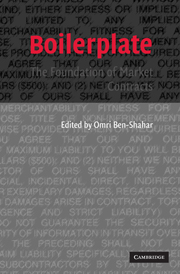Book contents
- Frontmatter
- Contents
- Preface
- List of Contributors
- PART ONE WHY IS BOILERPLATE ONE-SIDED?
- PART TWO SHOULD BOILERPLATE BE REGULATED?
- PART THREE INTERPRETATION OF BOILERPLATE
- 11 Contract as Statute
- 12 Modularity in Contracts: Boilerplate and Information Flow
- 13 Contra Proferentem: The Allure of Ambiguous Boilerplate
- PART FOUR COMMENTARY
- Notes
- Index
13 - Contra Proferentem: The Allure of Ambiguous Boilerplate
Published online by Cambridge University Press: 02 December 2009
- Frontmatter
- Contents
- Preface
- List of Contributors
- PART ONE WHY IS BOILERPLATE ONE-SIDED?
- PART TWO SHOULD BOILERPLATE BE REGULATED?
- PART THREE INTERPRETATION OF BOILERPLATE
- 11 Contract as Statute
- 12 Modularity in Contracts: Boilerplate and Information Flow
- 13 Contra Proferentem: The Allure of Ambiguous Boilerplate
- PART FOUR COMMENTARY
- Notes
- Index
Summary
Editor's Note:In this chapter, Michelle E. Boardman explores the proper interpretation of boilerplate language in insurance contracts. Insurers care a great deal about the certainty of meaning (which they can price). Courts trust that the contra proferentem doctrine will give insurers an incentive to change unclear language, but after a term has been interpreted contra proferentem, insurers may prefer to stick with this more certain pro-consumer meaning.
Bad boilerplate can shake one's faith in evolution; not only does it not die away, it multiplies. The puzzle is why. Much of boilerplate is ambiguous or incomprehensible. This alienates consumers and is increasingly punished by courts construing the language against the drafter. There must, therefore, be some hidden allure to ambiguous boilerplate. The popular theory is trickery: Drafters lure consumers in with promising language that comes to nothing in court. But this trick would require consumers to do three things they do not do — read the language, understand it, and take comfort in it.
There is a hidden allure to ambiguous boilerplate, but the trick lies in the courts, not the consumer. The trick is a private conversation between drafters and courts; excused from the table is the consumer, who could have no fair duty to understand and so has no duty to read. With the consumer out of the room, edits and additions to boilerplate are targeted to courts alone. The new language does not need to make sense to a layman.
- Type
- Chapter
- Information
- BoilerplateThe Foundation of Market Contracts, pp. 176 - 186Publisher: Cambridge University PressPrint publication year: 2007
- 1
- Cited by

